Planting, growing and caring for tomatoes in a greenhouse at home
Growing large, juicy, ripe tomatoes is the dream of every summer resident. In the conditions of most regions of our country, this is difficult because of the unpredictability of the weather and the short summer. Tomatoes, when grown in a greenhouse, ripen earlier, give a larger yield, have a better taste and presentation. Consider the features of the greenhouse method of growing tomatoes.
Content
- 1 Advantages and disadvantages of growing tomatoes in a greenhouse
- 2 Deciding on a variety for greenhouses
- 3 Step-by-step technology for planting tomatoes
- 4 Transfer to the greenhouse
- 5 Caring for tomatoes in the greenhouse
- 6 The nuances of caring for tomatoes
- 7 How to achieve a good harvest in greenhouse conditions
- 8 Harvesting tomatoes
Advantages and disadvantages of growing tomatoes in a greenhouse
There are pros and cons to growing tomatoes in greenhouse conditions that need to be considered, especially for novice gardeners.
Benefits of greenhouses:
- earlier, almost a month, ripening of tomatoes;
- high yield;
- protection against adverse weather effects - frost, lack of heat, hail;
- the possibility of planting thermophilic and indeterminate species;
- protection against pests.
Indoor tomatoes tend to be of better quality and presentation due to growth in favorable conditions.
The disadvantages of greenhouse cultivation include:
- additional costs for construction, heating, maintenance of greenhouses;
- constant control over the temperature, since at t above 30 ° there is a risk of slowing down the formation of the ovary and the loss of tomatoes;
- the need for pollination measures;
- treatment and protection against fungal infections;
- combating condensation.
In cold regions, greenhouse cultivation is the only way to get a good harvest that ripens on the bush. The costs are always paid off by the yield and excellent taste of the fruit.
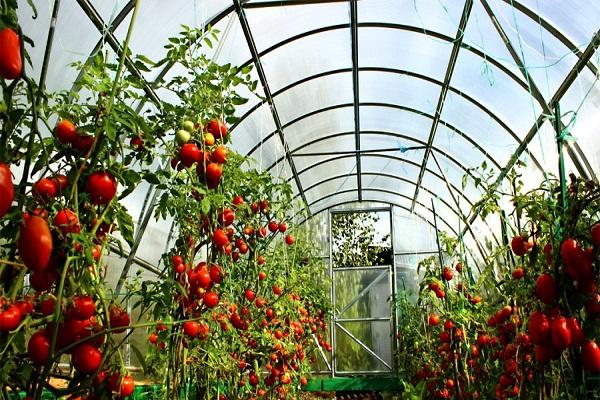
Deciding on a variety for greenhouses
Only an experienced gardener can understand the variety of varieties and hybrids. What to look for when choosing a seed:
- ripening time;
- determinant and indeterminate species;
- yield;
- hybrids - show good qualities of disease resistance.
Let's note the most popular types of tomatoes for greenhouse planting:
- early - Miracle of the Earth, Aurora F1, Sanka, Raspberry surprise, Budenovka, President 2 F1;
- fruitful - De Barao, Black Prince, Ilyich, Honey Drop, Auria, Pink Pearl;
- large ones - Bull's heart, Cardinal, Mazarin, Grandma's secret, King of giants, Volgograd;
- disease resistant - Ural, Tatiana, De Barao, Dubok, Morozko, Tea rose.
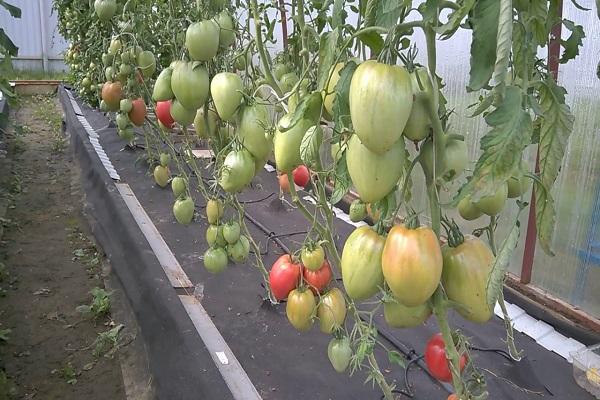
The ratings of favorite greenhouse varieties and hybrids are traditionally headed by De Barao, Bull's Heart, Eagle's Beak, Golden Domes.
For planting, it is recommended to choose well-known and familiar varieties, as well as new hybrids.
Step-by-step technology for planting tomatoes
The preparation of the greenhouse for the spring planting of tomatoes begins after the harvesting of the old tops, that is, in the fall. The remnants of the roots are removed from the ground, the fallen leaves are collected. This is done especially carefully if the plants are sick.
The structure is washed with water from a hose, repaired, metal parts are treated to remove rust. The tree is washed with antibacterial and antifungal agents. The top layer of soil is removed. Some of this work can be carried out in the spring, but it is correct to carry out the treatment for fungal diseases immediately after harvesting the tops so that the rot does not grow.
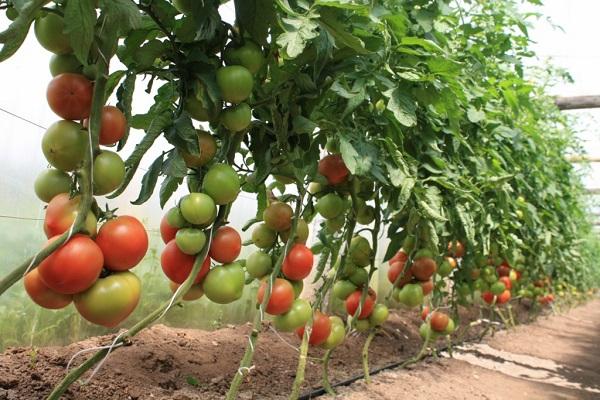
Processing is carried out with a solution of copper sulfate, fumigation with sulfur bombs. The beds can be prepared in the fall.
Important: in the greenhouse, it is necessary to have several vents for ventilation - in the side walls and on the ceiling.
Sowing seeds
Seeds are sorted before planting, rejecting small, curved and chipped seeds. Check germination by dropping it into a glass with saline solution. Seeds that float within 5 minutes are discarded.
Soak in Fitosporin solution prepared according to the instructions. It is also helpful to soak the seeds in a growth promoter.
The time of planting seeds depends on the growing season of the variety and the temperature characteristics of the region. Basic rules for sowing dates:
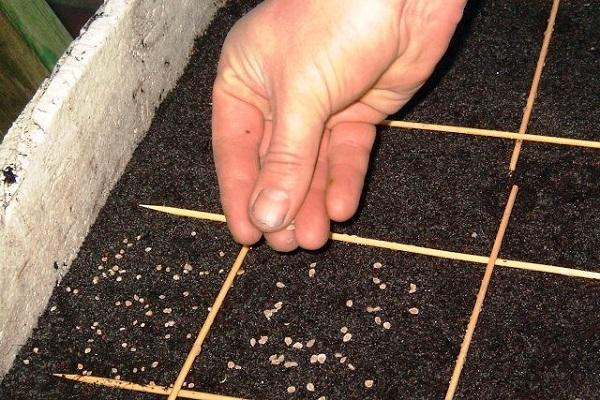
- end of February - for late varieties and warm regions;
- early-mid-March - mid-season species for the Middle Strip;
- end of March - the earliest varieties and hybrids.
Tomatoes are sown in containers about 15 centimeters high, deepening by 1-1.5 centimeters. For planting, use a special soil for seedlings or prepare a soil mixture yourself. The distance between the seeds is 2-3 centimeters.
Germinating pre-sowing material or squeezing dry seeds is the choice of the gardener. Note that when planting, the sprouts often break, maximum care is required and work with tweezers.

Germination of seedlings
After disembarkation, the containers are transferred to a lighted place with a temperature of 20-22 °. Immediately or after 3-5 days, cover with a transparent film to obtain a greenhouse effect with good moisture and maintain a constant temperature.
We adhere to the following rules when growing:
- until the growth of the leaves begins (third and further), watering is not needed - light moistening with a spray gun;
- in low light - use electric fluorescent lamps;
- turn boxes for uniform illumination;
- dive into separate containers when 2 true leaves appear (usually 2 weeks after germination).
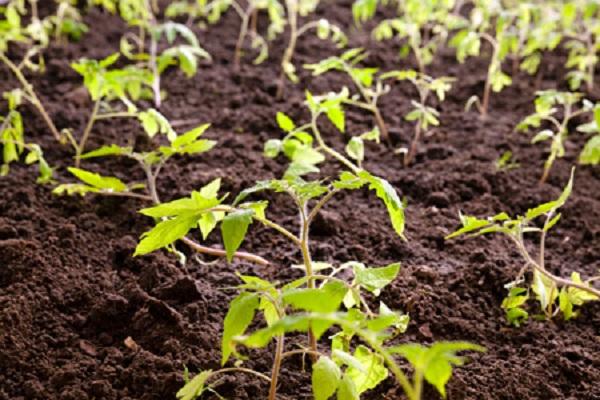
When transplanting into an individual pot, it is important not to touch the seedling, to grab more land so as not to expose the roots. In the future, the containers need to be turned with the other side towards the light so that the seedlings do not bend and develop evenly.
Tempering helps to grow high-quality seedlings. It begins with a gradual decrease in the temperature in the room, ventilation with cold outdoor air. 10 days before being transferred to the greenhouse, containers with plants are taken out onto a veranda or loggia with a temperature of at least 12 °.
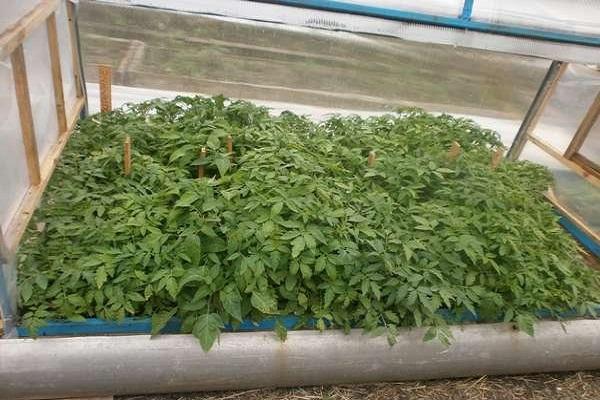
Transfer to the greenhouse
Stationary greenhouses are prepared in the fall, washing the walls, decontaminating them. It is important to remember that tomatoes are not planted in one place for two years in a row, they can be alternated with cucumbers.
When to transplant
Seedlings are transplanted into unheated greenhouses when the danger of frost has passed and the weather is stable. This usually occurs in the first decade of May.
By this time, the seedlings should have the following characteristics:
- the height of the seedlings is 15 centimeters for low-growing varieties, 30 centimeters for high;
- more than 8 sheets per bush;
- the stem is wide and dense in the lower part;
- there are 1-2 ovaries with buds, but no fruit.
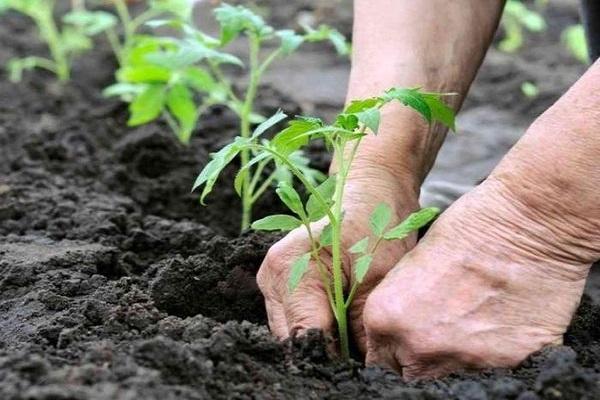
The ground inside the greenhouse should warm up to 12-15 °. To transfer seedlings to a greenhouse, choose an evening or a cloudy day.
Preparing the soil
The initial stage of soil preparation is to remove the top layer by 20 centimeters. Next, well-rotted manure is introduced, which is filled with new earth from above. Requirements for the composition of soils for tomatoes are high. When preparing the beds, it is also necessary to add sand, peat.
To loosen the soil, earthworms are buried in the ground, you can also buy and water future beds with a bacterial cocktail. Thanks to the vital activity of bacteria, the properties of the soil will improve, it will be easier for tomatoes to assimilate nutrients.

We apply fertilizers
An important factor in soil composition is acidity. For tomatoes, the norm is a neutral composition with a pH of 6-7 units. If there is a shortage, lime is added in a volume of 0.5 kilograms per square meter.
It is also recommended to add potassium sulfate and superphosphate, focusing on the composition of the soil and recommendations for fertilization.
To disinfect and warm the earth, the soil is spilled with a warm (60 °) solution of potassium permanganate (1 gram per 10 liters of water) and covered with a film.
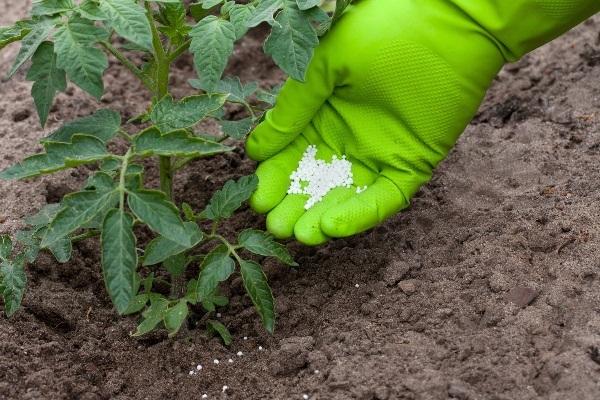
Tomato planting scheme
Tomatoes are planted in longitudinal beds. The number of beds is determined by the width of the greenhouse. The width of the bed is chosen according to the varieties planted, usually 60-90 centimeters. Large branchy bushes need more space, and passages are also made wider.
Modern methods of tomato farming recommend the following planting schemes:
- Chessboard for tall branchy tomatoes. The distance is 60-70 centimeters, between the beds for the passage - 70-80 centimeters.
- Fast maturing varieties with several stems are planted in a checkerboard pattern. Distance - 35-40 centimeters between neighbors, between rows - 55-60 centimeters.
- Standard species, as well as determinant ones, with one stem - in rows with a distance of 45-50 centimeters. Between holes - 30-35 centimeters.
It is important to remember that an excess of tomatoes in the greenhouse will not increase the yield.
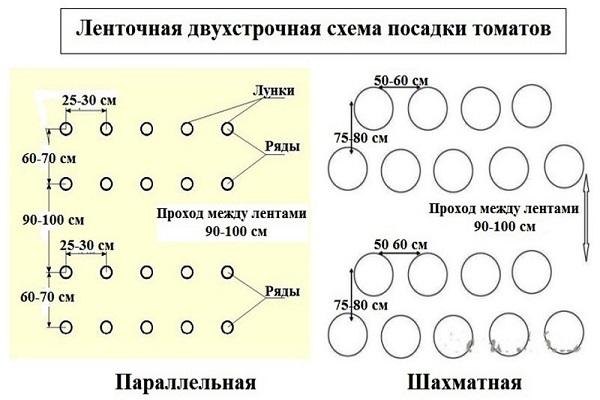
Important: thickening interferes with airing, provokes the accumulation of moisture, the development and rapid spread of fungal diseases.
We plant seedlings in the beds
Seedlings in peat pots are placed directly in the holes; in other cases, the seedlings with an earthen clod are carefully removed and placed vertically so that the foliage does not touch the soil.
If the tomatoes are overgrown, it is not recommended to put the stem in the hole. Dig a hole for the depth necessary for vertical standing, covering only the root system with earth and leaving part of the stem open. The hole is completely covered in 10-14 days, when the stem becomes coarse.
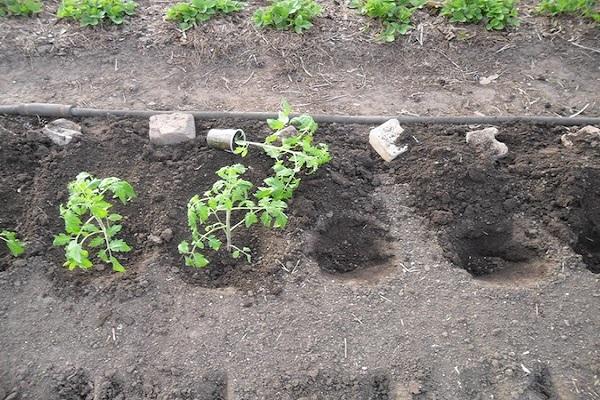
Caring for tomatoes in the greenhouse
To grow tomatoes in a greenhouse helps to know the basic rules of care, which consists in watering, feeding and pinching. It is also necessary to monitor the appearance of pests and diseases in tomato bushes.
Grassing tomato bushes
Removing excess shoots growing from the leaf sinuses allows you to free the bush, provide air access, and does not take away the energy from the plant for the extra green part.
The stepsons break off at a size of 5-8 centimeters, simply with their fingers or cut off with a pruner. The best time for pinching is morning. So that the sprout does not appear in the same place again, 2 centimeters of the stem are left when removed.
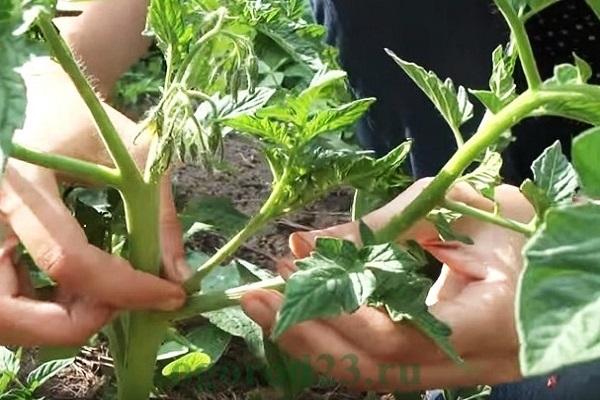
Irrigation regularity
Choosing the right watering regime helps to speed up growth and ovary formation. The first 7-8 days young seedlings are not watered. In the future, the following irrigation rates are recommended:
- young seedlings - 3 liters per bush after 3-5 days;
- at flowering and beginning of fruiting - 5 liters per plant once a week.
The best way to supply water is drip. Water cannot be cold, the temperature must correspond to the soil temperature.The best time is morning and evening, preferably morning. Water is poured at the root, without soaking the green part.
To prevent excess water from turning into condensation on the walls of the greenhouse, after irrigation, the soil is covered with organic mulch, which will later become a fertilizer.
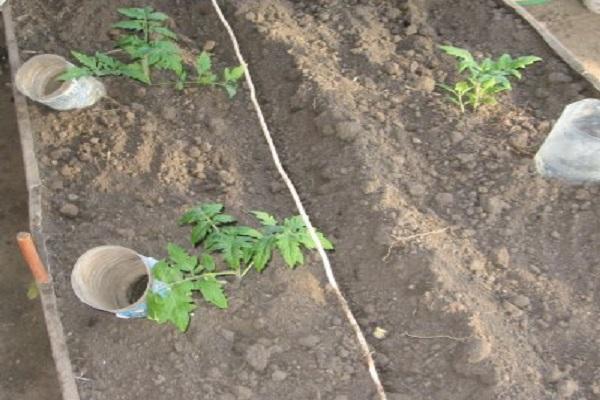
Drip irrigation systems help uniform water supply without excess, while fertilizing is applied.
How and what to feed seedlings and adult bushes
Fertilize tomatoes 3-4 times during the period of growth and fruiting. Most summer residents try to use organic fertilizers, spreading manure in each top dressing.
Terms of feeding:
- After 2 weeks from disembarkation - nitrophoska (NPK-complex), mullein. Consumption - a tablespoon of nitrophosphate, 500 grams of manure per 10 liters. The norm is a liter at the root.
- After 10 days. Potassium sulfate (1 teaspoon), manure. 5 liters per square meter.
- After 2 weeks - superphosphate (1 spoon), ash (2 tablespoons) per 10 liters. 5-7 liters per square meter.
When tomatoes begin to sing en masse, summer residents use sodium humate and superphosphate for additional plant support.

Garter and bush formation
The most hardworking summer residents have two trellises along the garden bed at different heights, to which the bushes are tied as they grow. Seedlings are attached 1-2 weeks after planting to the lower trellis, as the bushes grow, they are transferred to the upper one. It is especially important to have 2 levels for tall bushes with large fruits and high yields.
Gardeners also recommend removing the lower leaves from the bushes. Rot often develops on the foliage below the ovary. All other leaves with traces of disease and damage are also cut off.
Treatment against pests and diseases
Having planted tomatoes in a greenhouse, you need to constantly monitor the condition of the bushes and ovaries in order to notice diseases and pests in time.
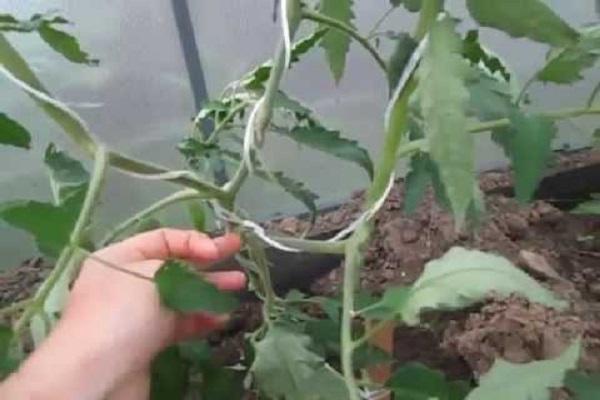
Diseased leaves and fruits are immediately removed, if the bush is significantly affected, it must be dug up and burned. More often than others, fungal diseases develop, which provoke excess moisture and poor ventilation. In this case, the greenhouse is dried by opening the doors and windows in dry weather.
Phytophthora is the most common greenhouse disease. It will be necessary to process all plants with Phytosporin or analogues, remove all excess leaves and cover the soil with mulch.
With root rot, the soil is shed well with Alirin-B, Trichocin or Glyocladin. These are biological substances that release natural antibiotics.
Important: for greenhouses it is better to choose varieties with increased resistance to diseases and carry out preventive soil and plant treatment with Fitosporin-M.
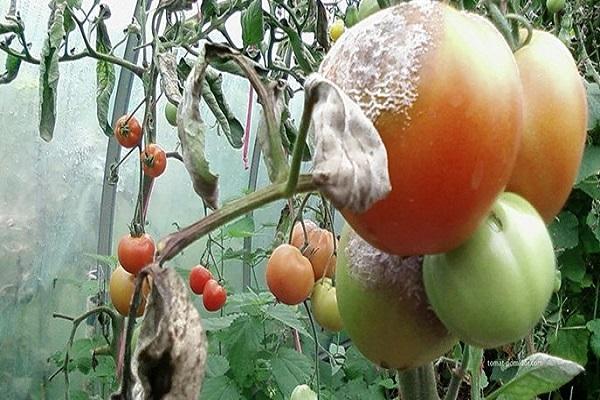
The nuances of caring for tomatoes
Greenhouses should be located in well-lit areas with an east-west orientation. With a lack of sunlight, tomatoes do not grow well, shedding the ovary. It is recommended to maintain the humidity in the greenhouse not higher than 65%, otherwise fungal diseases will develop.
You need to take care of the tomatoes constantly, airing, feeding on time, observing the recommended watering scheme.
For pollination, the tomato brushes are gently shaken during flowering to ensure the movement of pollen. It is useful to open greenhouses, to attract bees and other insects, they put fragrant flowers, jam, honey or compote.
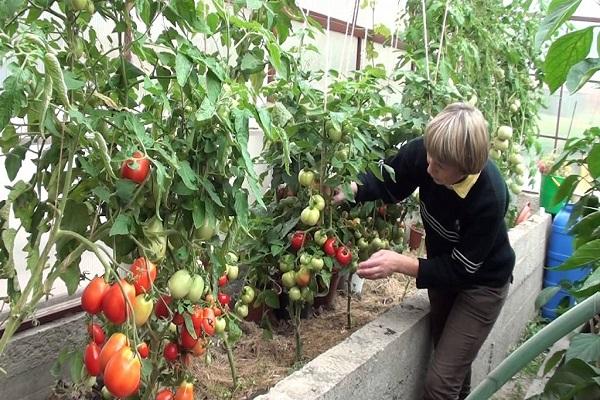
In a winter greenhouse
In winter greenhouses with good heating, tomatoes are planted a month earlier (in April), using early varieties of tomatoes that are resistant to fungal and viral diseases. In greenhouses, a second layer is added from the film to provide insulation.
When grown in a greenhouse, the same agricultural rules should be followed as in greenhouse conditions. They are made in the southern high parts of the garden with a low groundwater table.
In order for tomatoes to grow well, they are illuminated for up to 16-18 hours a day, providing a temperature of 20-25 °, at night - not lower than 15 °.
Growing tomatoes in winter requires stationary greenhouses, a special regime and appropriate knowledge of agricultural technology.
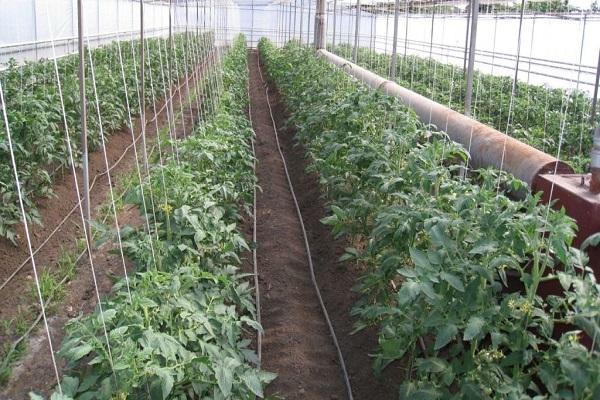
In an unheated greenhouse
Greenhouses without heating help maintain the desired temperature for tomatoes during cold snaps, protect against frost and excess precipitation. They create favorable conditions for constant growth, allow you to grow tomatoes before ripening on a bush, which is important for cold regions.
The first crop is harvested much earlier than in the open field, in late June, early July.
The secrets of growing a good crop are choosing the right varieties and complete care focused on greenhouse conditions.
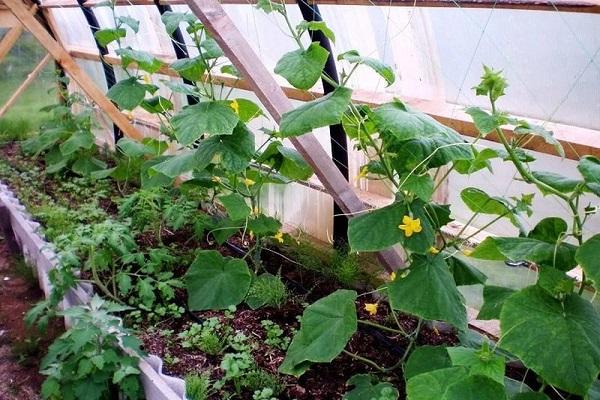
How to achieve a good harvest in greenhouse conditions
Growing tomatoes in greenhouses requires compliance with certain conditions that help increase yields:
- In the heat, doors and vents should be open. If the greenhouse is film, the bottom edge must be folded back. High temperatures prevent the formation of ovaries, at low temperatures, growth slows down.
- Airing is required. Tomatoes are not afraid of drafts; fans can be used to enhance air movement.
- Compliance with the regime of watering, feeding.
- Mulching the soil and wiping the walls to remove condensate. Humidity 60-65%.
- Temperature range - 22-25 ° during the day, up to 15 ° at night.
- Protection against pests and diseases, removal of diseased leaves and plants.
- Helping tomatoes in pollination.
The correct choice of varieties will provide tasty tomatoes for the whole season and will allow you to make winter preparations.
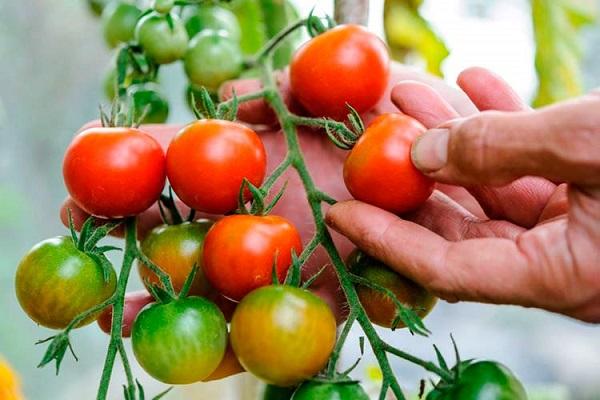
Harvesting tomatoes
When harvesting, the following rules are observed:
- the stalks are left on the bush;
- milk ripeness (brown) tomatoes are best removed so that other ovaries grow faster;
- in spring tomatoes are harvested every 2-3 days (planted in winter), in summer - every day;
- for seeds, tomatoes are kept on a bush until they are fully ripe.
Note that if the temperature drops to 7-8 °, the tomatoes are harvested completely, they will not be able to grow and sing.

For ripening, green tomatoes are laid out in a dark room with a temperature of 15-20 °. The container with tomatoes must be ventilated, the number of layers is 1-3. Red tomatoes accelerate the ripening of green ones, with their help they slow down or increase the ripening time of the bulk.
Growing tomatoes in greenhouses helps most summer residents to get tasty juicy fruits. Breeders are constantly developing new varieties and hybrids that are more resistant to diseases and give a stable harvest in greenhouse conditions. In the process of work, each summer resident gains his own experience, finds the best ways to solve the problems that arise when growing thermophilic tomatoes.
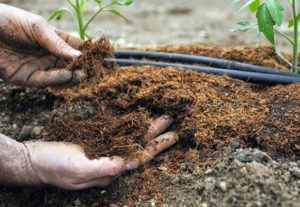
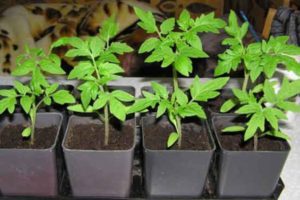

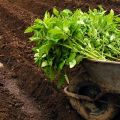


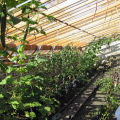
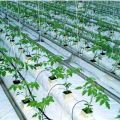
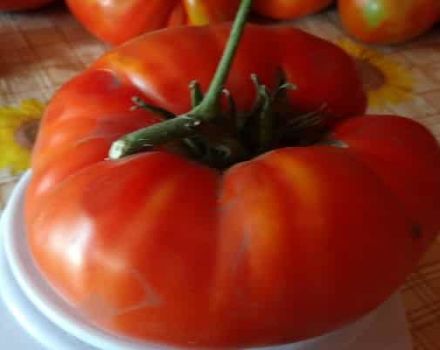

Regular watering of seedlings is very important for tomatoes, thanks to this they become very sweet and juicy. In the summer, you need to treat bushes from pests much more often, otherwise the entire seedlings may suffer.